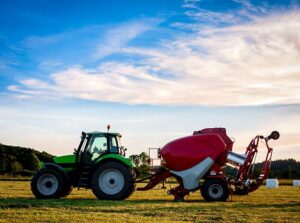Silage plastic is a serious contender for hay baling.
The agricultural industry has seen a major shift in the last few decades with the advent of modern technology and innovations. One such innovation, NetWrap silage plastic, has been pivotal in transforming hay baling practices, offering myriad benefits that significantly enhance hay quality and farm productivity.
 Hay baling is a crucial process for farmers, preserving fodder for livestock during winter. It involves the preservation of harvested crops in a compact format that is low in moisture. Traditionally, this process was time-consuming and labour-intensive, involving extensive drying and storage procedures.
Hay baling is a crucial process for farmers, preserving fodder for livestock during winter. It involves the preservation of harvested crops in a compact format that is low in moisture. Traditionally, this process was time-consuming and labour-intensive, involving extensive drying and storage procedures.
The introduction of NetWrap silage plastic has revolutionised this process. Silage plastic, an airtight and UV-resistant plastic film wraps and seals hay bales, creating an anaerobic environment that accelerates fermentation and prevents spoilage. This method, known as silage, effectively retains the hay’s nutritional value, providing quality fodder for livestock.
Silage plastic also offers improved flexibility in hay baling that was not possible before. It is easier to transport and stack due to its uniform shape, while farmers can use the film on different types of crops regardless of size or moisture levels. Furthermore, the airtight seal helps preserve hay for longer, significantly reducing the wastage of valuable fodder in winter months.
The benefits of silage plastic in hay baling are immense and have revolutionised the agricultural industry. It reduces costly losses associated with traditional hay baling methods, improves farm productivity, and creates healthier, more nutritious fodder for livestock. Additionally, it is an efficient, cost-effective solution that ensures improved quality control in the long run.
One of the most prominent advantages of silage plastic is its role in preserving the nutrient content of hay. In traditional hay baling methods, the prolonged drying often leads to a loss of nutrients, specifically proteins and carbohydrates, essential for livestock health. By enabling faster fermentation, silage plastic locks in these nutrients and reduces losses, resulting in nutritious, high-quality fodder.
Silage plastic is also a more economical way of storing hay. Its airtight seal helps retain moisture, preventing spoilage and cutting down on the cost of drying and storage. The increased productivity associated with this method reduces costs that would have otherwise gone to labour and manual equipment. Moreover, silage plastic can be reused for multiple years if maintained and stored properly, making it an economical solution in the long term.
Another significant advantage is the reduction of waste. It’s not uncommon for a proportion of hay to be wasted in traditional methods due to adverse weather conditions, pest infestations, or improper storage. The use of silage plastic significantly reduces this wastage, ensuring almost all of the harvested crop is usable.
The benefits of silage plastic in hay baling are undeniable, significantly improving farm productivity and the quality of hay used for livestock. It is an efficient and cost-effective solution to traditional methods, with its airtight seal ensuring optimum moisture levels and nutrient retention over a longer period. As the agricultural industry continues to evolve, silage plastic will remain an essential part of hay baling for the foreseeable future.
Silage plastic is highly cost-effective. The initial investment may be high. However, the benefits far outnumber the costs. Due to its effectiveness in preserving hay for a long period and reducing wastage, farmers save on time and labour and maximise their yield.
Silage plastic also offers benefits in terms of labour and time efficiency. Wrapping and sealing the hay bales is quicker and requires less manpower than traditional methods. This, coupled with the reduced drying time, allows farmers to harvest and store larger volumes of hay in a shorter span, boosting productivity.
Moreover, silage plastic makes hay storage easier and more manageable. Bales wrapped in silage plastic are easier to transport and store, taking up less space than traditional bales. This significantly reduces the chances of deteriorating quality due to improper handling or exposure to adverse weather conditions.
The environmental benefits of silage plastic are also worth mentioning. Reducing waste minimises the need for additional land for hay production. Furthermore, the plastic used for silage is recyclable, significantly lowering the environmental footprint of farming practices.
